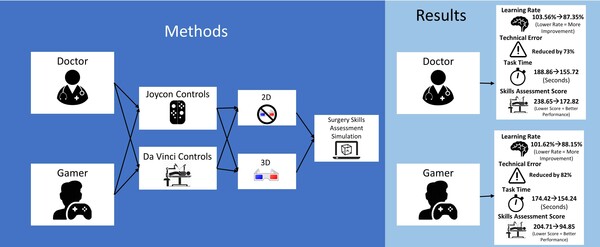Nintendo Da Vinci: A Novel Control System to Improve Performance in Robotic-Assisted Surgery
(1) Veterans Memorial High School, Corpus Christi, Texas, (2) Driscoll Children’s Hospital, Corpus Christi, Texas
https://doi.org/10.59720/19-045
Complications of robotic-assisted surgery are on the rise, partly due to surgeons not receiving proper training. Using the current Da Vinci (DV) surgical system, surgeons require anywhere between 50 and 3,000 surgeries to achieve adequate proficiency. To improve performance, we have developed a new system using Nintendo Joycon (NJ) controls. We hypothesized the NJ controls would improve surgical performance, so we compared the NJ and DV systems with two user groups (doctor and gamer). The doctor and the gamer performed a defined task using NJ and the DV control systems, in a simulated skills assessment in 2-dimensional (2D) and 3D modes. The task completion time and error rate were used to calculate a Fundamentals of Robotic Surgery Skills Assessment (FRS) score. The FRS was then used to calculate the learning rate using the learning rate formula. The task completion time, error rate, FRS scores, and the learning rate were significantly better with NJ. The error rate risk ratios indicated that the DV control system carried a higher risk of error compared to the NJ control system. The NJ control system was associated with a better task completion time by 83% for the doctor and 88% for the gamer, a lower error rate by 73% for the doctor and 82% for the gamer, better FRS score by 72% for the doctor and 46% for the gamer, and better LR by 84% for the doctor and 86% for the gamer. This study shows that implementing a NJ control system is associated with improved surgical performance and LR compared to DV.
This article has been tagged with: